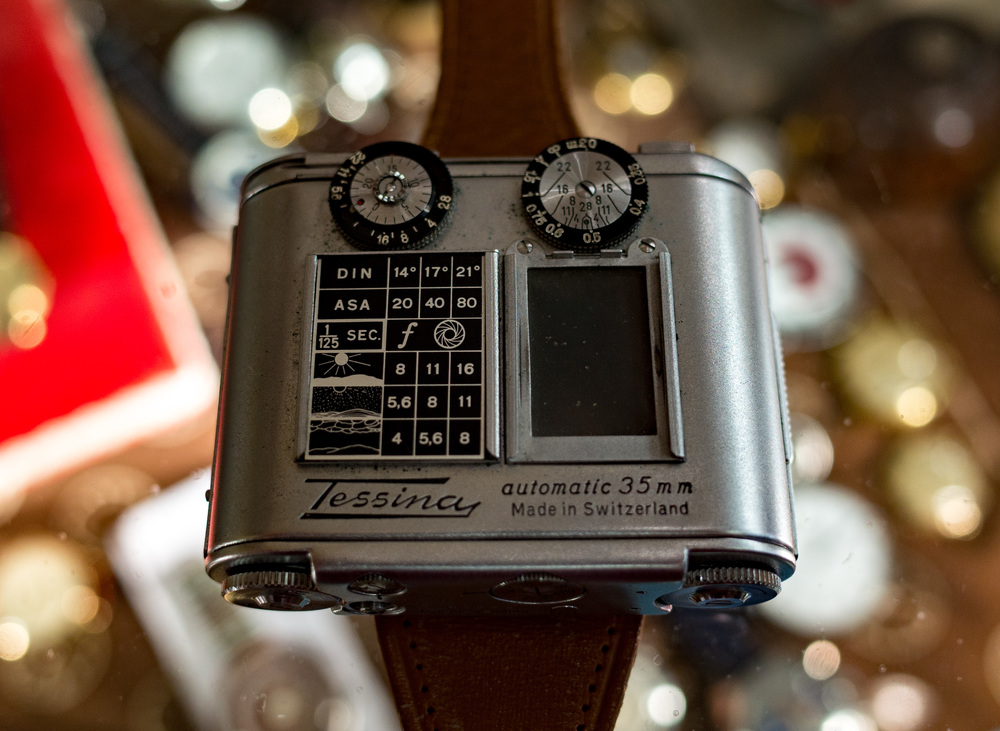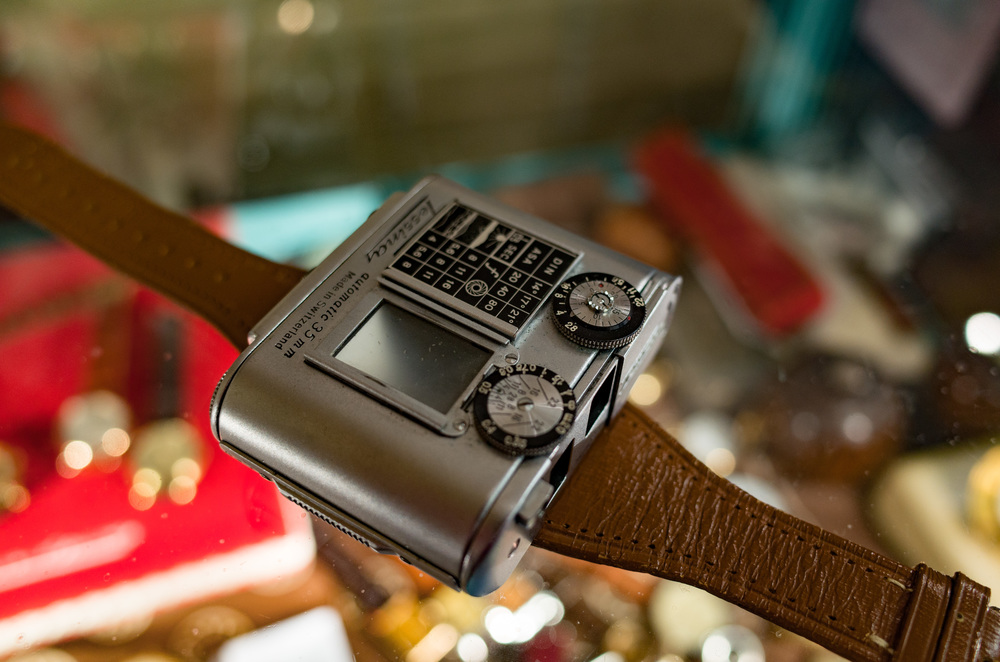
The face of London’s Portobello Road market is constantly changing. The various arcades tend to attract stalls of similar persuasion and, recently, birds of the vintage watche feather have been flocking to the Red Tea Pot arcade at No.101, turning it into something of a Mecca for the watch enthusiast. Watches are a peripheral interest of mine, coming a very poor second to cameras, but I like to take a stroll around to see what is on offer.
Last week I found something to excite both watch and camera addicts: The Tessina 35mm miniature spy camera decked out with a wrist band and ready for some subversive action.
The Tessina 35 was invented by an Austrian chemical engineer, Dr.Rudolf Steinbeck and manufactured between 1957 and 1996 in Gretchen, Switzerland. It is the smallest 35mm film camera ever made, even smaller than the Minox 35, and can be worn on the wrist like a watch.
The camera is only slightly larger than a matchbox at 65 x 50 x 20mm and could be easily concealed, for instance in a pack of cigarettes or in a bag. The chrome example I found on Martyn J. Stamp’s stall was the most popular style but the camera was also made in red, gold and black.
The astounding aspect of the Tessina is that it is a twin-lens reflex with two 25mm f/2.8 Tessinon lenses. The ground-glass window on the top, beneath the aperture dial, is for composing the picture. The image is projected onto standard 35mm film by means of an internal mirror. The film is advanced by a clockwork master spring built into the takeup spool, powered by a pull-out winder similar to the crown on a wristwatch.

In its day, special cassettes, holding enough film for eight exposures, were available but are now long since discontinued.
The Tessina was used by the infamous Stasi (state security service) in East Germany before the fall of communism. One was even used by Watergate conspirator Howard Hunt during an office burglary in August 1971.
Martin is selling the Tessina 35 for £500, assuming it hasn’t already been snapped up. You can contact him at ukwatchltd@btopenworld.com
You can find a full description of the Tessina 35 here at the Crypto Museum
_____________
- Subscribe to Macfilos for free updates on articles as they are published. Read more here
- Want to make a comment on this article but having problems? Please read this

This brings back memories of shooting with a Tessina in the 1960s. The wrist strap enabled skiers and climbers to have a small camera available when out on the mountains. It was built with typical Swiss precision and produced commendable results. Being clockwork driven it could never be a quiet camera. For that reason I doubt that it ever appealed to serious spies and wonder why it collected that label.
I think it took more than eight shots per load. They would have been exposed in one burst. Twenty-four seems more likely, though I recall there was a bulk loading accessory for recharging cassettes. So it was possible to have shorter reloads if needed.
I’ve just discovered this article now that the new Macfilos layout provides links to all sorts of odd goodies!
I used to have one of these (around 1978, I think ..wow: 40 years ago!) which I bought from Andrews of Teddington. Mine came complete with the ugly “Visoflex”-like slip-on eye-level pentaprism, which turned the preview or finder screen into a right-way-up unreversed left-for-right proper viewfinder, just like an SLR (..except that it is a TLR!).
The article says “..The image is projected onto standard 35mm film by means of an internal mirror..” but doesn’t mention that this was a half-frame 35mm camera – hence the lenses are 25mm, not 50mm. It didn’t have any built-in exposure meter, but many cameras didn’t when this was built ..so you just guessed the right exposure (1/125 @ f5.6 was usually about right in dull weather outdoors).
The article says “..In its day, special cassettes, holding enough film for eight exposures, were available..” but I seem to remember that mine did – I thought – up to 24 exposures ..it was, I think, the motor-drive SPRING which was good for 8 exposures, and then needed re-winding.
It was a lovely piece of miniaturisation, and took great photos – though with more depth-of-field, naturally, than a full-frame camera of the same aperture. I think mine cost £300 back around ’78, so £500 would be great value today, if you really wanted, or needed, one (..though I see that this article was written in 2016). But I knew after about 6 months that I really didn’t need it – though it was interesting to use it for a while – and so I sold it back to Andrews and got my money back!
I’d forgotten about that, David. I didn’t know anything about the camera and did a bit of research, so blame me if the facts are wrong. I also discussed it with Ivor at Red Dot Cameras since he had just bought one for his museum. It’s on display there if you visit the shop. I’m sure he’d let you fondle it to bring back old memories. Incidentally, it’s amazing how the new layout is encouraging readers to trawl back through old posts. This is by no means the first one and we’re only four days into the new site.